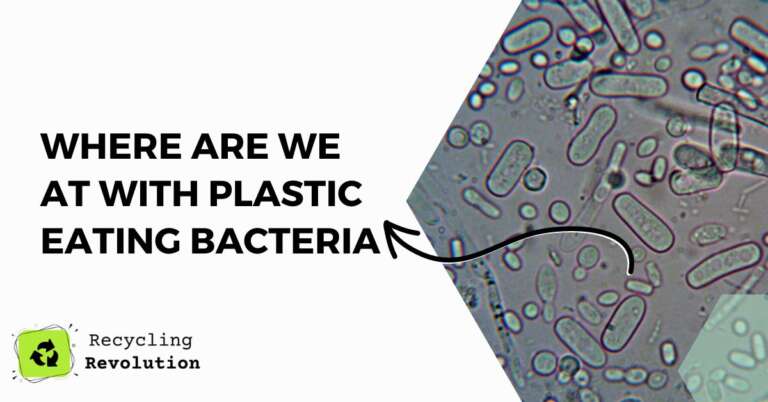Do you ever stop to think about what happens to the plastic you throw away?
Most of it ends up in landfills, where it can take hundreds of years to decompose, or worse, in our oceans and waterways, where it harms wildlife and ecosystems.
But what if there was a solution to this problem? What if there were bacteria that could eat plastic?
Plastic-eating bacteria are a promising solution to the problem of plastic pollution.
These microorganisms have the ability to break down plastics into their component parts, making them an eco-friendly alternative to traditional waste management methods.
🧴 Plastic Recycling Estimator
🔍 Plastic Buyback Facts
Most buyback programs accept PET (water bottles), HDPE (detergent containers), and PP (caps, cups). Light plastics like bags and wrappers are harder to recycle, but containers and jugs are highly valued. Recycling plastic reduces landfill overflow and saves fossil fuels.
What Are Plastic-Eating Bacteria?
Plastic-eating bacteria, also known as plastic-degrading bacteria, are microorganisms that have the ability to break down plastics.
There are various types of plastic-eating bacteria, including Ideonella sakaiensis, Pseudomonas putida, and Rhodococcus ruber, among others.
These bacteria use enzymes to break down the complex polymer chains in plastics into smaller, more manageable molecules.
Research on Plastic-Eating Bacteria
Research on plastic-eating bacteria has been ongoing to find a working solution again micro plastics and plastic polution. In 2016, Japanese researchers discovered Ideonella sakaiensis, a bacterium that can break down PET (polyethylene terephthalate), one of the most common types of plastic used in bottles and containers.
Since then, other types of plastic-degrading bacteria have been discovered, and researchers continue to study their abilities and potential applications.
Applications of Plastic-Eating Bacteria
Plastic-eating bacteria have a wide range of potential applications, from waste management to bioremediation.
In waste management, plastic-eating bacteria could be used to break down plastic waste in landfills, reducing the amount of plastic that ends up in these sites.
In bioremediation, plastic-eating bacteria could be used to clean up areas contaminated with plastic waste, such as beaches and waterways.
Here’s what can and cannot be decomposed by plastic-eating bacteria:
| Plastic Trash Items | Can Be Decomposed by Plastic Eating Bacteria | Cannot Be Decomposed by Plastic Eating Bacteria |
|---|---|---|
| Plastic bags | Yes | – |
| Plastic cutlery | Yes | – |
| Plastic straws | Yes | – |
| Plastic food wrap | Yes | – |
| Plastic bottles | Yes | – |
| Plastic caps | Yes | – |
| Plastic packaging | Yes | – |
| Plastic toys | Some types can be decomposed | Some types cannot be decomposed |
| Plastic foam | Some types can be decomposed | Some types cannot be decomposed |
| Plastic film | Some types can be decomposed | Some types cannot be decomposed |
Environmental Impact and Safety Considerations
While plastic-eating bacteria offer a promising solution to plastic pollution, there are also potential risks and safety considerations associated with their use.
One concern is the potential for genetically modified bacteria to accidentally escape into the environment, leading to unintended consequences.
There is also the risk that plastic-eating bacteria could harm non-plastic materials or other organisms in the environment.
Moreover, the bacteria might not be able to break down all types of plastic, and their effectiveness might depend on various factors such as temperature, humidity, and the type of plastic.
How long does it take to decompose plastic in the environment?
Plastics take a long time to decompose in the environment.
The exact amount of time it takes for plastic to decompose depends on several factors, such as the type of plastic, environmental conditions, and other factors.
For example, a plastic water bottle can take up to 450 years to decompose in a landfill.
During this time, it can release harmful chemicals into the environment, which can have detrimental effects on wildlife and ecosystems.
Therefore, it is crucial to reduce our plastic usage and properly dispose of plastic waste to prevent further damage to the environment.
How long does it take to decompose plastic with plastic-eating bacteria
In as little as 6 weeks a piece of plastic can be completely decomposed, but it gets a little more complicated than that.
According to a study published in Environmental Science and Technology, researchers found that the plastic-eating bacterium Ideonella sakaiensis could break down a thin film of PET plastic in about six weeks under lab conditions.
However, this is a relatively short amount of time compared to the hundreds of years it can take for plastic to decompose naturally in the environment.
It’s important to note that the effectiveness of plastic-eating bacteria can depend on various factors, such as the type of plastic, environmental conditions, and the specific type of bacteria being used.
For example, other studies have shown that plastic-eating bacteria may not be effective in breaking down certain types of plastics, such as polypropylene.
Can Microplastics be solved with Plastic Eating Bacteria?
Yes, there have been some interesting scientific findings to suggest that we are not far away from treating the microplastics problem in the environment.
However
Research has shown that some types of plastic-eating bacteria can break down microplastics into smaller pieces.
For example, a study published in Frontiers in Microbiology found that a type of bacteria called Pseudomonas aeruginosa could degrade microplastics in marine environments.
Other studies have also found that plastic-eating bacteria such as Ideonella sakaiensis and Rhodococcus ruber can break down small pieces of plastic.
While plastic-eating bacteria offer a promising solution to plastic pollution, further research is needed to determine their effectiveness in breaking down microplastics in the environment without adverse environmental effects.
There are concerns about the potential risks associated with the use of genetically modified bacteria and the safety of introducing these bacteria into the environment.
Learn about the individual studies
- A study published in Frontiers in Microbiology in 2020 found that Pseudomonas aeruginosa, a common bacterium found in the marine environment, was able to degrade microplastics in seawater. The researchers found that the bacteria could break down microplastics into smaller pieces and produce enzymes that could help degrade the plastic.
https://www.frontiersin.org/articles/10.3389/fmicb.2020.01661/full - Another study published in the journal Applied and Environmental Microbiology in 2018 found that a bacterium called Rhodococcus ruber was able to break down microplastics into smaller fragments in the soil. The researchers found that the bacteria produced enzymes that could break down the plastic, and the process was more effective when the bacteria were grown in the presence of microplastics.
https://aem.asm.org/content/84/17/e01006-18 - According to a report by the Ellen MacArthur Foundation, it is estimated that there will be more plastic than fish in the ocean by weight by 2050 if current trends continue. Microplastics are a significant contributor to this problem, as they can be ingested by marine organisms and enter the food chain.
https://www.ellenmacarthurfoundation.org/publications/the-new-plastics-economy-rethinking-the-future-of-plastics - A study from the Environmental Science and Technology Letters in 2021 found that plastic pollution is a significant problem in freshwater ecosystems, with microplastics being the most common form of plastic pollution. The study found that plastic-eating bacteria could potentially help to reduce the amount of plastic pollution in freshwater systems.
https://pubs.acs.org/doi/10.1021/acs.estlett.1c00218
Conclusion
In conclusion, plastic-eating bacteria offer a potential solution to the problem of plastic pollution.
While there are still challenges and safety considerations that need to be addressed, the potential benefits of plastic-eating bacteria are significant.
With ongoing research and development, plastic-eating bacteria could become a valuable tool in the fight against plastic pollution, helping to protect our planet and the creatures that call it home
FAQ
Is plastic eating bacteria harmful?
Plastic eating bacteria are generally not harmful to humans.
However, there is still ongoing research on their safety and potential risks associated with their use.
Why is plastic eating bacteria not used?
Plastic eating bacteria are still a relatively new and emerging technology, and there are several challenges that need to be addressed before they can be widely used.
One of the main challenges is scaling up the technology to be effective on a large scale.
How long does it take for plastic eating bacteria to eat plastic?
The time it takes for plastic eating bacteria to eat plastic can vary depending on the type of plastic and the conditions in which the bacteria are grown.
In some cases, it can take several months or even years for the bacteria to break down the plastic.
Where do plastic eating bacteria live?
Plastic eating bacteria can be found in a variety of environments, including soil, water, and the digestive tracts of animals.
Some bacteria have also been found to live on plastic surfaces, such as in landfills or on plastic debris in the ocean.

